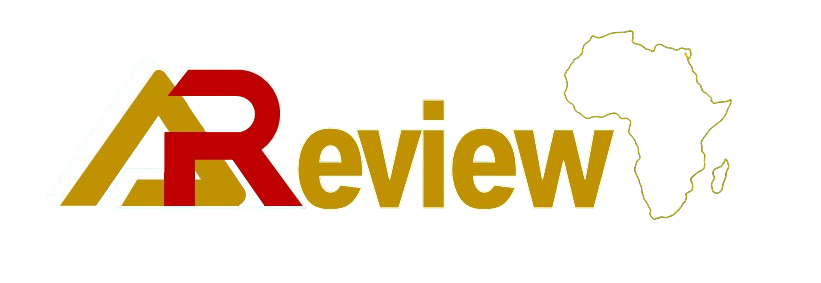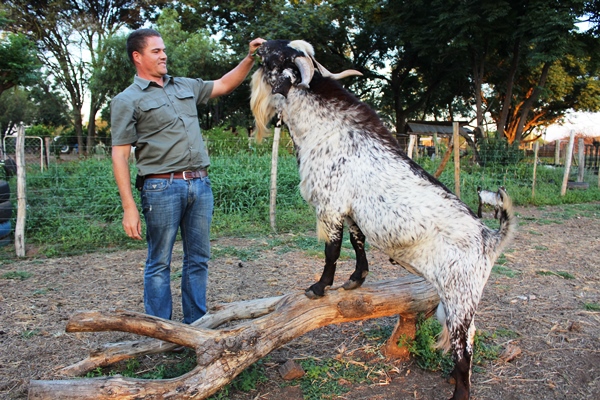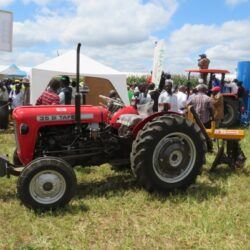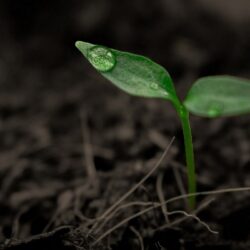Louis and Gerhard Lourens farm indigenous goats on a smallholding in Waterval, in Gauteng Province, South Africa.
The Lourens family lives in a ‘smallholder belt’ north of Pretoria, one of South Africa’s two capital cities. If one thinks about it, there are probably smallholder belts in the outer corridors of most of the world’s major cities.
Some smallholders grow meat, milk or fresh produce for home consumption – others may sell excess produce to friends and neighbours. Then there are those who find that demand for their product grows beyond the ability of the smallholding to supply it. These operations may expand into something bigger, and more commercial.
THE LAND AND THE COMMUNITY
This family moved onto their smallholding five years ago with no experience, or knowledge, of farming. “We knew nothing about farming when we decided to do this, but we’ve learnt a lot,” says Gerhard.
‘We knew nothing about farming when we decided to do this’
What they’ve done proves that you don’t have to be a master farmer to follow your dream, if you really want to farm.
“But you should stay humble and learn from other farmers with more experience,” says Louis.
The father-and-son team bought a 14ha block of land with two houses, which meant that both families could be comfortable. Their farming business has now outgrown the 14ha, and they have negotiated with neighbours to lease an additional 24 hectares of grazing. “We put up the fencing and maintain it. They give us the grazing on a 10 year lease. It’s a good deal,” says Louis.
Smallholders tend to be community-minded and usually help their neighbours when there’s a problem. It’s how farmers survive really, whether they are big or small. In the Waterval area, groups get together and share-lease machinery at planting, mowing, baling or harvesting times. It cuts the costs and spreads the benefits.
This kind of business-based community thinking works in much the same way as a co-operative. It’s a winning concept for small-scale producers because it gives them more buying, selling and trading power.
The story of successful smallholders usually begins with a job. To keep cash coming into the new farming venture and to support the family, one or two members of the project must work. Gerhard and his stepmom, Carmen, work in town at the family business, an industry supplier of safety products, tools, welding equipment and machinery.
He commutes 50km a day (25km each way) and farms on weekends.
Louis, retired from the business, farms full-time and is on the management team of the Indigenous Veld Goat Society of South Africa.
SELF SUFFICIENT
Goat
Chickens are confined in a large, fenced chicken hok. Gerhard explains that they are kept in so that they don’t destroy the vegetable gardens.
Part of their farming vision was to “go off grid” says Gerhard. By off-grid he means not just off the power grid, but self-reliant. Much of the power is solar, and most of the food, milk from the goats, red meat from home-grown livestock, vegetables grown in the vegetable garden, comes from the farm.
Gerhard and his wife, Jani, don’t buy processed baby food for their four-month-old son, Leon. “Everything he eats is fresh and unprocessed,” says Gerhard. “Do the sums,” Louis adds. “If one egg costs R2 (K1.47) and our chickens cost us R5 (K3.69) a day in feed for a 30egg/day output, we’re winning.”
THE ANIMALS
They started up with two Boergoat ewes and a Kalahari Red ram. But about five months later, Gerhard and Louis jumped at the chance of buying a flock of indigenous, Northern Cape Speckled goats and began to focus on stud breeding. The first breeding group contained one ram and 15 ewes.
goat
Umkhulu is the top sire in Louis and Gerhard’s flock of 200 Northern Cape Speckled goats.
Handsome animals, with beautiful, symmetrically marked hides, they have decent meat capacity on medium- to large-frames, good milking and maternal ability, disease and parasite resistance, and high tolerance to sun and heat.
Gerhard explains the exceptional productivity of the Northern Cape Speckled breed: “They lamb every eight months, or three times in two years, and our ewes have an 80% twinning rate.”
Goat
A Northern Cape Speckled ewe in the night camp. The speckled goats have red/brown markings or black markings with a solid band of colour running down the topline and stipples of colour down the flanks. The markings are symmetrical.
The Lourens team has selected for the twinning trait because it accelerates their flock growth. They try to steer clear of triplets if at all possible, because the third lamb often has to be hand-raised which creates extra work. “A really strong mom with good maternal ability will raise three babies,” says Gerhard, “but it’s definitely a maintenance issue for her, and we don’t encourage that trait.”
‘A really strong mom with good maternal ability will raise three babies’
Productivity is exceptional with population increases of 200% possible. “If I have 100 breeding ewes, in one year I can increase the flock to 300 animals,” says Louis. Of course this will not happen in an operation with a sloppy management style, but with efficient oversight and diligent management it is entirely possible.
In a small-scale farming operation, the farmer has to think things through carefully, says Louis. “When we bale grass for winter feed, we bring in a local chap with a square baler, because the square bales can easily be handled by one man. There is no extra labour around.”
The smallholder farmer must cut every possible cost because he does not have the economy of scale that the large-scale farmer has. Both are commercial farmers, farming for profit, but the numbers are different, and the margins are different. The principles of profit are the same.
goat
In the late afternoon the goats are taken into the night camps. They stay in their groups at all times to maintain breeding integrity. Louis says they kraal them at night to prevent stock theft.
FEEDING
The Lourens’ property is not big enough to supply the flock with its feed and nutrition requirements. In winter too, the grass frosts off so there is no effective grazing in the colder months. This means that food must be bought in, a practice referred to in farming circles as ‘feeding from the bag’.
Every farmer understands that the more you feed from the bag, the less profit you will make. The solution to this problem is to grow food to take livestock through the leaner times of the year. Stored, home-grown feed feels a little like a strong positive balance on your credit card – good.
Goat
The creep feeder keeps the bigger goats out and lets the lambs in to eat their ration.
There are lush stands of Babala grass and maize now. “We can put the animals onto the grass for restricted grazing, we can cut and bale it and we can make silage out of it,” Louis explains. He has bought a hammer mill to process home-grown maize for feed.
The animals get a Molatek production lick in summer, and a protein, mineral and trace element supplement (Winterlek) in winter. Goats are kraaled at 4pm and let out in the morning at 7am when they are taken to separate, fenced camps. Rams run with specific ewe groups and it is important to keep them apart because of the breeding programmes.
goat
Babala grass is good for grazing, baling and ensiling. Louis says the Babala is a quick grower and he is very happy with this field, his first planting of the grass.
BREED ADVANCEMENT
The first international auction for indigenous goats is to be held in Upington on 24, 25 and 26 May to coincide with the Upington Agricultural Show. Upington is close to the South African border with Namibia and reasonably close to Botswana. For buyers from Zambia and Botswana there will be quarantine facilities.
The Indigenous Goat Society encourages farmers to join so that they can network, learn from one another and get support from like-minded people. When farmers get together to talk and help one another – they’re an unstoppable force.
Goat
A fine example of breeding a Northern Cape Speckled ram to a British Alpine milk goat. The cross improves the milk capacity of the animal without reducing disease resistance and hardiness.
For more information contact Louis Lourens at email louis@jacage.com or phone him on +2782 853 1758




